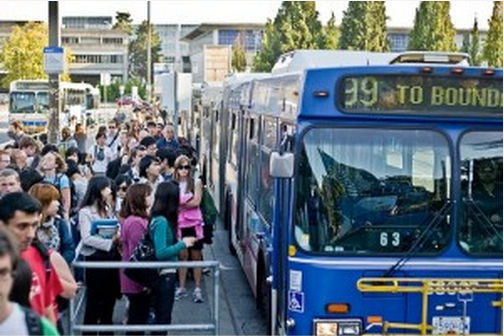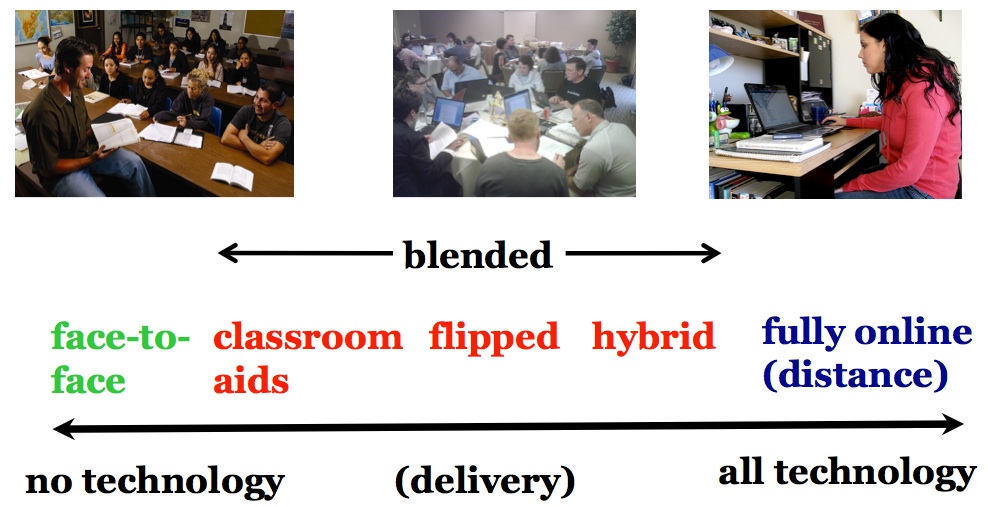
In Chapters 6, 7 and 8, the use of media incorporated into a particular course or program was explored. In this chapter, the focus is on deciding whether a whole course or program should be offered partly or wholly online. In Chapter 10 the focus is on deciding when and how to adopt an approach that incorporates ‘open-ness’ in its design and delivery.
9.1.1 The many faces of online learning
Online learning, blended learning, flipped learning, hybrid learning, flexible learning, open learning and distance education are all terms that are often used inter-changeably, but there are significant differences in meaning. More importantly, these forms of education, once considered somewhat esoteric and out of the mainstream of conventional education, are increasingly taking on greater significance and in some cases becoming mainstream themselves. As teachers and instructors become more familiar and confident with online learning and new technologies, there will be more innovative methods developing all the time.
At the time of writing though it is possible to identify at least the following modes of delivery:
- classroom teaching with no technology at all (which is very rare these days);
- blended learning, which encompasses a wide variety of designs, including:
- technology-enhanced learning, or technology used as classroom aids; a typical example would be the use of Powerpoint slides and/or clickers;
- the use of a learning management system to support classroom teaching, for storing learning materials, set readings and perhaps online discussion;
- the use of lecture capture for flipped classrooms;
- one semester on a residential-type campus and two semesters online (the Royal Roads University model);
- a shortened time on campus spent on campus hands-on experience or training preceded or followed by a concentrated time spent studying online (an example is apprenticeship training for mature students at Vancouver Community College, or what the University of British Columbia calls the compressed classroom experience);
- hybrid or flexible learning requiring the redesign of teaching so that students can do the majority of their learning online, coming to campus only for very specific face-to-face teaching, such as lab or hands-on practical work, that cannot be done satisfactorily online (for examples, see below);
- fully online learning with no classroom or on-campus teaching, which is one form of distance education, including:
- courses for credit, which will usually cover the same content, skills and assessment as a campus-based version;
- non-credit courses offered only online, such as courses for continuing professional education;
- fully open courses, such as MOOCs;
- open educational resources, available for free downloading online, which either instructors or students can access to support teaching and learning.
There is an important development within blended learning that deserves special mention, and that is the total re-design of campus-based classes that takes greater advantage of the potential of technology, which I call hybrid learning, with online learning combined with focused small group face-to-face interactions or mixing online and physical lab experiences. In such designs, the amount of face-to-face contact time is usually reduced, for instance from three classes a week to one, to allow more time for students to study online.
In hybrid learning the whole learning experience is re-designed, with a transformation of teaching on campus built around the use of technology. For instance:
- Carol Twigg at the National Center for Academic Transformation has for many years worked with universities and colleges to redesign usually large lecture class programs to improve learning and reduce costs through the use of technology. This program has been running successfully since 1999;
- Virginia Tech many years ago created a successful program for first and second year math teaching built around 24 x 7 computer-assisted learning supported by ‘roving’ instructors and teaching assistants (Robinson and Moore, 2006);
- The University of British Columbia launched in 2013 what it calls a flexible learning initiative focused on developing, delivering, and evaluating learning experiences that promote effective and dramatic improvements in student achievement. Flexible learning enables pedagogical and logistical flexibility so that students have more choice in their learning opportunities, including when, where, and what they want to learn.
Thus ‘blended learning’ can mean minimal rethinking or redesign of classroom teaching, such as the use of classroom aids, or complete redesign as in flexibly designed courses, which aim to identify the unique pedagogical characteristics of face-to-face teaching, with online learning providing flexible access for the rest of the learning.
9.1.2 The continuum of online learning
Thus there is a continuum of technology-based learning:

(adapted from Bates and Poole, 2003)
9.1.3 Decisions, decisions!
These developments open up a whole new range of decisions for instructors. Every instructor now needs to decide:
- what kind of course or program should I be offering?
- what factors should influence this decision?
- what is the role of classroom teaching when students can now increasingly study most things online?
- if content is increasingly open and free, how does that affect my role as an instructor?
- when should I create my own material and when should I use open resources?
- should I open up my teaching to anyone, and if so, under what circumstances?
This chapter aims to help you answer these questions.
Activity 9.1 Where on the continuum are your courses?
1. If you are currently teaching, where on the continuum is each of your courses? How easy is it to decide? Are there factors that make it difficult to decide where on the continuum any of your courses should fit?
2. How was it decided what kind of course you would teach? If you decided, what were the reasons for the location of each course on the continuum?
3. Are you happy with the decision(s)?
Please use the comment box below to share your responses.
References
Bates, A. and Poole, G. (2003) Effective Teaching with Technology in Higher Education: Foundations for Success San Francisco: Jossey-Bass
Robinson, B. and Moore, A. (2006) Virginia Tech: the Math Emporium in Oblinger, D. (ed.) Learning Spaces Boulder CO: EDUCAUSE